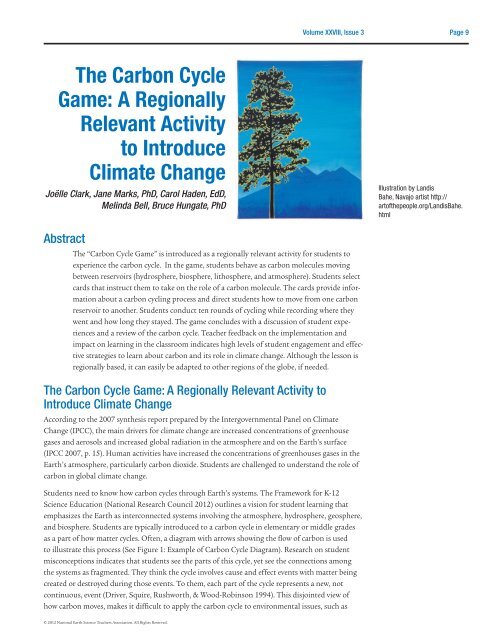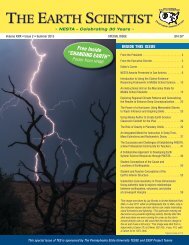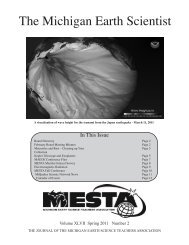The Earth Scientist
Fall 12.pdf - NESTA
Fall 12.pdf - NESTA
- No tags were found...
Create successful ePaper yourself
Turn your PDF publications into a flip-book with our unique Google optimized e-Paper software.
Volume XXVIII, Issue 3<br />
Page 9<br />
<strong>The</strong> Carbon Cycle<br />
Game: A Regionally<br />
Relevant Activity<br />
to Introduce<br />
Climate Change<br />
Joëlle Clark, Jane Marks, PhD, Carol Haden, EdD,<br />
Melinda Bell, Bruce Hungate, PhD<br />
Illustration by Landis<br />
Bahe, Navajo artist http://<br />
artofthepeople.org/LandisBahe.<br />
html<br />
Abstract<br />
<strong>The</strong> “Carbon Cycle Game” is introduced as a regionally relevant activity for students to<br />
experience the carbon cycle. In the game, students behave as carbon molecules moving<br />
between reservoirs (hydrosphere, biosphere, lithosphere, and atmosphere). Students select<br />
cards that instruct them to take on the role of a carbon molecule. <strong>The</strong> cards provide information<br />
about a carbon cycling process and direct students how to move from one carbon<br />
reservoir to another. Students conduct ten rounds of cycling while recording where they<br />
went and how long they stayed. <strong>The</strong> game concludes with a discussion of student experiences<br />
and a review of the carbon cycle. Teacher feedback on the implementation and<br />
impact on learning in the classroom indicates high levels of student engagement and effective<br />
strategies to learn about carbon and its role in climate change. Although the lesson is<br />
regionally based, it can easily be adapted to other regions of the globe, if needed.<br />
<strong>The</strong> Carbon Cycle Game: A Regionally Relevant Activity to<br />
Introduce Climate Change<br />
According to the 2007 synthesis report prepared by the Intergovernmental Panel on Climate<br />
Change (IPCC), the main drivers for climate change are increased concentrations of greenhouse<br />
gases and aerosols and increased global radiation in the atmosphere and on the <strong>Earth</strong>’s surface<br />
(IPCC 2007, p. 15). Human activities have increased the concentrations of greenhouses gases in the<br />
<strong>Earth</strong>’s atmosphere, particularly carbon dioxide. Students are challenged to understand the role of<br />
carbon in global climate change.<br />
Students need to know how carbon cycles through <strong>Earth</strong>’s systems. <strong>The</strong> Framework for K-12<br />
Science Education (National Research Council 2012) outlines a vision for student learning that<br />
emphasizes the <strong>Earth</strong> as interconnected systems involving the atmosphere, hydrosphere, geosphere,<br />
and biosphere. Students are typically introduced to a carbon cycle in elementary or middle grades<br />
as a part of how matter cycles. Often, a diagram with arrows showing the flow of carbon is used<br />
to illustrate this process (See Figure 1: Example of Carbon Cycle Diagram). Research on student<br />
misconceptions indicates that students see the parts of this cycle, yet see the connections among<br />
the systems as fragmented. <strong>The</strong>y think the cycle involves cause and effect events with matter being<br />
created or destroyed during those events. To them, each part of the cycle represents a new, not<br />
continuous, event (Driver, Squire, Rushworth, & Wood-Robinson 1994). This disjointed view of<br />
how carbon moves, makes it difficult to apply the carbon cycle to environmental issues, such as<br />
© 2012 National <strong>Earth</strong> Science Teachers Association. All Rights Reserved.






